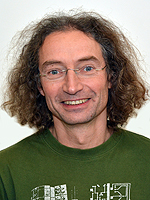About the Seminar
Cell penetrating peptides have a unique potential for targeted drug delivery, therefore, mechanistic understanding of their membrane action has been sought since their discovery over 20 years ago. While ATP-driven endocytosis is known to play a major role in their internalization, there has been also ample evidence for the importance of passive translocation for which the direct mechanism, where the peptide is thought to directly pass through the membrane via a temporary pore, has been widely advocated. In this talk, I will question this view and demonstrate that arginine-rich cell penetrating peptides can instead enter vesicles and cells by inducing multilamellarity and fusion, analogously to the action of calcium ions. The molecular picture of this penetration mode, which differs qualitatively from the previously proposed direct mechanism, is provided by molecular dynamics simulations. In addition, the kinetics of vesicle agglomeration and fusion by nonaarginine, nonalysine, and calcium ions are documented in real time by fluorescence techniques and the induction of multilamellar phases in vesicles and cells is revealed both via electron microscopy and fluorescence spectroscopy. We thus show that the newly identified passive cell penetration mechanism is analoguous to vesicle fusion induced by calcium ions, demonstrating that the two processes are of a common mechanistic origin.
Allolio C., Magarkar A., Jurkiewiczf P., Baxová K., Javanainen M., Mason P.E., Sachl R., Cebecauer M., Hof M., Horinek D., Heinz V., Rachel R., Zieglerg C.M., Schrofel A., Jungwirth P.: Arginine-rich cell-penetrating peptides induce membrane multilamellarity and subsequently enter via formation of a fusion pore. Proceedings of the National Academy of Sciences USA 115 (2018) 11923.
About the Speaker
The Jungwirth Lab aims at gaining molecular level understanding of biological processes involving ions using computer simulations in close contact with spectroscopic experiments. Using molecular dynamics simulations and quantum chemical methods we are attempting to establish the mechanisms of ion-protein interactions responsible for the salting out (Hofmeister) series and beyond. Applications of our research range from influencing protein aggregation, precipitation, or denaturation and controlling enzymatic activity to establishing properties of phospholipid bilayers in the presence of ions. One of the key aims within the latter subject is to establish molecular principles governing the action of calcium ions involved in membrane fusion and |cationic cell penetrating peptides (important, e.g., for novel ways of drug delivery to cells). Our related research activities concern electron solvation pertinent to radiation chemistry and DNA damage. And in our free time we entertain ourselves by “balcony experiments” involving, for example, explosions of alkali metals in water, which also allows us to connect to general public and popularize science.



